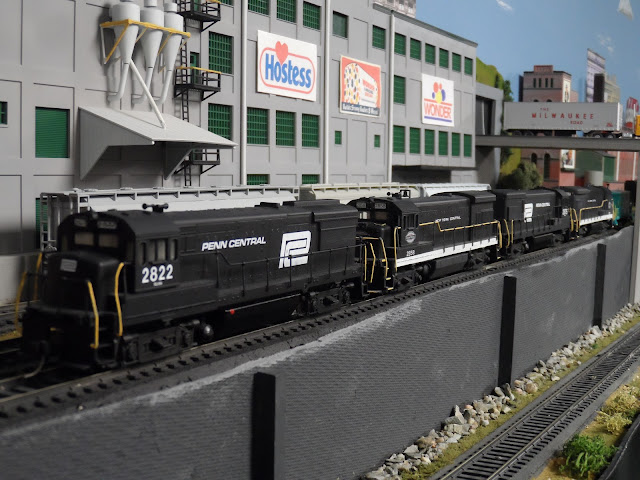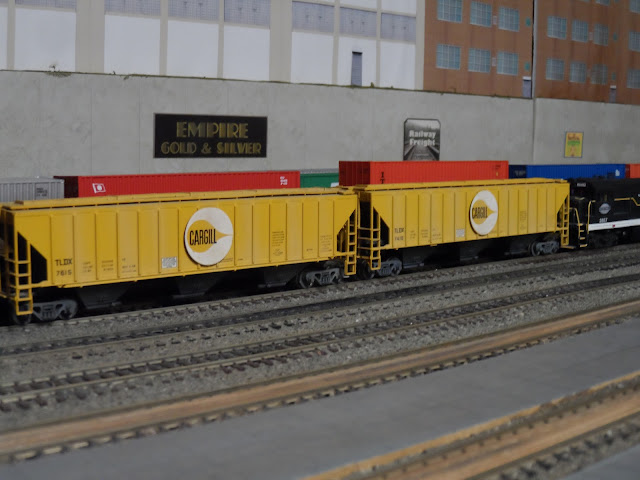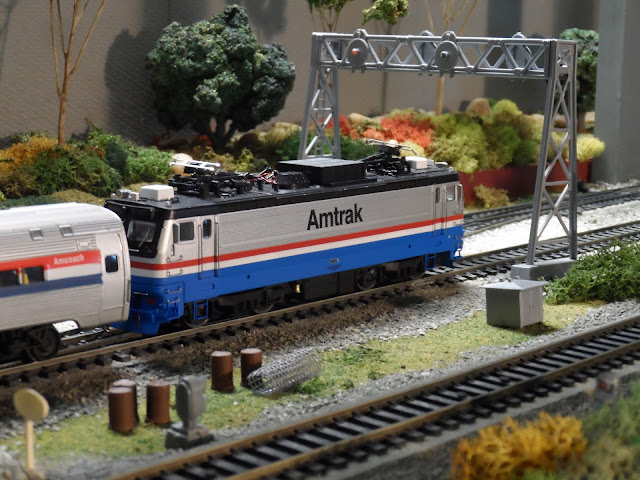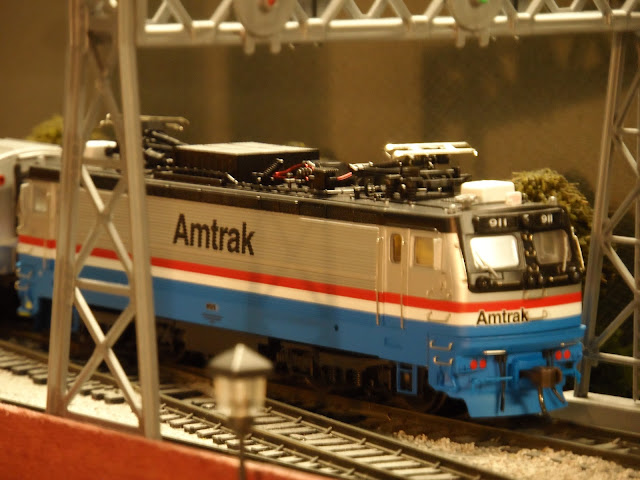Greetings All,
New Motors for the Blue Box Fleet
The NYCTL engine shop was busy this past month working to improve locomotive consisting capabilities and the overall performance for my Athearn Blue Box U28B and U30Bs.
Athearn BB U28Bs / U30Bs aka B-Boats
The four BB B-Boats in my fleet consist of two factory painted NYC U30Bs and two PC U28Bs that I painted on the Patti-O Paint Shop and lettered according to prototype photos in 2016. Two are powered with gold flywheel motors, one with an older non flywheel motor and one is non powered.
Prototype Information
The GE U25B was General Electric's first independent entry into the United States domestic road switcher diesel-electric locomotive railroad market for heavy production road locomotives since 1936. From 1940 through 1953, GE participated in a design, production, and marketing consortium (Alco-GE) for diesel-electric locomotives with the American Locomotive Company. In 1956 the GE Universal Series of diesel locomotives was founded for the export market. The U25B was the first attempt at the domestic market since its termination of the agreement with Alco.
"St Louis San Francisco GE U25B 807" by Digital Rail Artist is marked with CC0 1.0. To view the terms, visit https://creativecommons.org/publicdomain/zero/1.0/?ref=openverse.
The U25B (nicknamed U-Boat) was the first commercially successful domestic diesel electric road locomotive designed, built, and sold by General Electric after its split with the American Locomotive Company (Alco), a company dating back to the steam era.
"Pennsylvania Railroad GE U25B 2605" by Digital Rail Artist is marked with Public Domain Mark 1.0. To view the terms, visit https://creativecommons.org/publicdomain/mark/1.0/?ref=openverse.
The U25B was announced by General Electric as a domestic model on April 26, 1960. It was the first locomotive powered by GE's highly successful FDL-16 engine.
"Erie Lackawanna GE U25B 2504" by Digital Rail Artist is marked with CC0 1.0. To view the terms, visit https://creativecommons.org/publicdomain/zero/1.0/?ref=openverse.
The U-Boat put GE on the road to becoming the top locomotive producer in the U.S., much to the chagrin of EMD. It introduced many innovations to the U.S. diesel locomotive market, including a pressurized car body and a centralized air processing system that provided filtered air to the engine and electrical cabinet, thus reducing maintenance.
"4/1/75, PC U25B 2643" by OHFalcon72 is licensed under CC BY-NC-ND 2.0. To view a copy of this license, visit https://creativecommons.org/licenses/by-nc-nd/2.0/?ref=openverse.
The U25B was also the highest-horsepower four-axle diesel road locomotive in the U.S. at the time of its introduction, its contemporaries being the GP20 (2,000 HP) and the RS27 (2,400 HP.
"RI 202, GE U25B; Silvis, IL; December 1963" by San Diego Model Railroad Museum is licensed under CC BY-NC-ND 2.0. To view a copy of this license, visit https://creativecommons.org/licenses/by-nc-nd/2.0/?ref=openverse.
The GE U28B diesel-electric locomotive model replaced the U25B in early 1966, featuring a slightly uprated prime mover (300 HP more power than the U25B). Early units had the same car body styling as the U25B, while later units had design features (shortened nose) more in common with later models. After only a year of production, this model was superseded by the U30B.
The GE U28B diesel-electric locomotive model replaced the U25B in early 1966, featuring a slightly uprated prime mover (300 HP more power than the U25B). Early units had the same car body styling as the U25B, while later units had design features (shortened nose) more in common with later models. After only a year of production, this model was superseded by the U30B.
The PC operated five U28Bs, two from the NYC and three leased from the P&LE which were built on U25B frames.
"8/3/77, P&LE U28B 2810" by OHFalcon72 is licensed under CC BY-NC-ND 2.0. To view a copy of this license, visit https://creativecommons.org/licenses/by-nc-nd/2.0/?ref=openverse.The GE U30B was a diesel-electric locomotive produced by GE Transportation between 1966 and 1975. It was a further development of the U28B, with a 3,000 HP 16-cylinder prime mover. The U30B competed with the EMD GP40 and the ALCO Century 430, but was not as successful as the GE U30C.
PC U30B 2871 is one of sixty inherited from the New York Central (2830-2889). All were assigned to Selkirk for maintenance.
"12/74, PC U30B 2871" by OHFalcon72 is licensed under CC BY-NC-ND 2.0. To view a copy of this license, visit https://creativecommons.org/licenses/by-nc-nd/2.0/?ref=openverse.
The GE U33B is a diesel-electric locomotive that was offered by GE in 1966, featuring a 16-cylinder motor. The NYC bought two and the PC later purchased eighty one.
U33B 2943 is one of sixty six U33Bs (2890-2955) ordered by the Penn Central in late 1968. In 1970 the PC picked up another fifteen U33Bs (2956-2970) from a cancelled Rock Island order. All were assigned to Selkirk for maintenance.
"11/12/76, CR U33B 2943" by OHFalcon72 is licensed under CC BY-NC-ND 2.0. To view a copy of this license, visit https://creativecommons.org/licenses/by-nc-nd/2.0/?ref=openverse.
The four axle B-Boats above derived their railfan nicknames from their six axle big brother U-Boats to help distinguish between the two. Below we have a U33C and U25C in late 1976. Notice the leaves in the radiator of the lead unit.
"11/12/76, CR U33C 6551" by OHFalcon72 is licensed under CC BY-NC-ND 2.0. To view a copy of this license, visit https://creativecommons.org/licenses/by-nc-nd/2.0/?ref=openverse.
The four axle B-Boats above derived their railfan nicknames from their six axle big brother U-Boats to help distinguish between the two. Below we have a U33C and U25C in late 1976. Notice the leaves in the radiator of the lead unit.
"11/12/76, CR U33C 6551" by OHFalcon72 is licensed under CC BY-NC-ND 2.0. To view a copy of this license, visit https://creativecommons.org/licenses/by-nc-nd/2.0/?ref=openverse.
Model Information
The older non flywheel U30B motor is a fast runner and is not compatible with the gold flywheel motors in the U28Bs. This unit basically sat in the box unless I swapped shells with one of the other B-Boats.
A recent purchase of five used six axle Athearn BB gold flywheel motors along with the six Cargill covered hoppers reported in the prior post moved the project to upgrade the NYC/PC U28B-U30B blue box fleet forward.
Using A-Line Couplings I was able to install the Athearn six axle motor into the four axle U-Boat. DC has its advantages for these motor swaps!
The Four B-Boats look good consisted together for the first time.
The Four B-Boats look good consisted together for the first time.
The B-Boats make their first revenue run.
With most of the U-Boats and B-Boats assigned to Selkirk as their maintenance base having them as frequent visitors to Terminal Yard makes sense to me. The newly repowered U28B-U30B consist is joined by the remainder of my U-Boat, B-Boat fleet at Terminal Yard.
Four Bachmann Plus B23-7s that I painted and lettered as NYC U30Bs in June, 2011 and PC U33Bs in September 2023.
The two NYC units have been in the fleet and earning revenue for thirteen years.
Athearn BB PC 6557 was the only U-Boat with the red "P". I used some modelers license for this project from around 2017 using a U28C shell in lieu of a U33C shell. The U33C fleet was split between Selkirk, (6540-6548) and Buckeye (6549-6563).
The Athearn BB U33C 6554 is another unit I painted and lettered using a U28C shell in 2017. The middle unit is the 6533, a factory painted U28C that I purchased from Caboose Hobbies in Denver well over twenty years ago.
PRR U30C 6539 is a factory painted Athearn BB U30C that has been in the combined fleet for over twenty years.
U25C 6500 is a Rivarossi non powered unit that I received as a gift in 2018. The PRR purchased twenty U25Cs in 1965. All were assigned to Selkirk for maintenance.
Athearn BB PC U23Cs 6710 and 6718 were added to the PC fleet for yard power at Selkirk and Terminal Yard respectively. The PC purchased nineteen(19) U23Cs in late 1970. 6700-6703 were assigned to Buffalo, 6704-6709 were assigned to Enola and 6710-6718 were assigned to Selkirk for maintenance.
The Empire Belt added Athearn U23Cs 6719 and 6720 for yard power and transfer service at the same time as the PC. All U23Cs were originally painted and lettered by the Patti O Paint Shop in 2017 as U30Cs and later renumbered as U23Cs in 2019 which was more realistic for my needs.
The two NYC units have been in the fleet and earning revenue for thirteen years.
Athearn BB PC 6557 was the only U-Boat with the red "P". I used some modelers license for this project from around 2017 using a U28C shell in lieu of a U33C shell. The U33C fleet was split between Selkirk, (6540-6548) and Buckeye (6549-6563).
The Athearn BB U33C 6554 is another unit I painted and lettered using a U28C shell in 2017. The middle unit is the 6533, a factory painted U28C that I purchased from Caboose Hobbies in Denver well over twenty years ago.
PRR U30C 6539 is a factory painted Athearn BB U30C that has been in the combined fleet for over twenty years.
U25C 6500 is a Rivarossi non powered unit that I received as a gift in 2018. The PRR purchased twenty U25Cs in 1965. All were assigned to Selkirk for maintenance.
Athearn BB PC U23Cs 6710 and 6718 were added to the PC fleet for yard power at Selkirk and Terminal Yard respectively. The PC purchased nineteen(19) U23Cs in late 1970. 6700-6703 were assigned to Buffalo, 6704-6709 were assigned to Enola and 6710-6718 were assigned to Selkirk for maintenance.
The Empire Belt added Athearn U23Cs 6719 and 6720 for yard power and transfer service at the same time as the PC. All U23Cs were originally painted and lettered by the Patti O Paint Shop in 2017 as U30Cs and later renumbered as U23Cs in 2019 which was more realistic for my needs.
B-Boats in Action!!!
Other Re-Motor Projects
B&O F7A Back to the Shop
I attempted to replace the motor in this old Athearn BB F7A but was unsuccessful.
I swapped a six axle motor with a four axle version in one of the PC U28Bs but it wasn't even close to fitting in the space provided.
Amtrak 503 Rides Again!
Athearn BB SDP40F 503 received a new six axle motor. The original was balky and I thought I had it fixed but after sitting several days the motor wouldn't turn unless I nudged the flywheel. This was a simple drop in replacement.Final Thoughts & Comments
The five six axle gold flywheel motors originally believed to be a mix of four and six axle motors were purchased for $25.00 with free shipping. They have been more than worth that price. In fact this was another offer I couldn't refuse!!!
Thanks for reading and watching!!!
See you soon!!!
































































